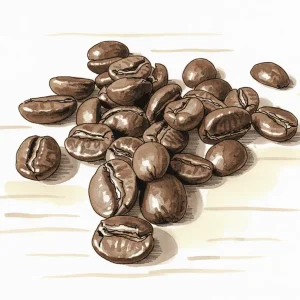Catuai
Catuai coffee originated in Brazil and became a beloved variety for its sweet, balanced flavor. Cultivated at high altitudes, it offers a smooth body with notes of chocolate and nuts, making it a crowd-pleasing choice for espresso and filter brews.
Catuai Beans
Showing 1–16 of 77 results
De goedkoopste prijzen per 1 kg worden weergegeven
-
Bant Sawk
€ 46,80 -
Bio Blend
€ 29,50 -
Bittersweet Symphony
van CoffeeXperts€ 28,97 -
Blendy Blend
van Man Met Bril€ 44,00 -
Brasil Capricornio Pioneiro
van Capriole Café€ 42,00 -
Brazil - Campo Alegre Espresso
€ 131,80 -
Brazil – Serra Dos Ciganos (zeiltransport)
van Koffiestation€ 40,50 -
Brazil Classic – Peaberry
€ 118,40 -
Brazil Santos Espresso
van Boot Koffie€ 39,00 -
Brazilie • Monte Belo
van De Eenhoorn€ 31,90 -
Brazilië | Ellen Fontana (espresso)
van Henry’s Coffee€ 28,50 -
Brazilië Sul de Minas
van CoffeeXperts€ 29,97 -
Brooklyn
€ 42,56 -
Cappuccino Melange
van CoffeeXperts€ 28,97 -
City Limits
€ 165,68 -
Classic Brazil
van BeanBrothers€ 144,00
More About Catuai
Origins and Development
Catuai coffee traces its origins back to Brazil in 1949. It was created by crossing two Arabica cultivars—Mundo Novo and Caturra—under the guidance of Dr. Alcides Carvalho at the Instituto Agronômico de Campinas. The goal was to combine Mundo Novo’s impressive yield with Caturra’s compact growth. After years of selection, Catuai was officially released to Brazilian farmers in 1972. Its name comes from the Tupi-Guarani language, meaning “very good,” reflecting high hopes for both productivity and flavor. Over the decades, Catuai expanded across Central America, including Guatemala, Honduras, and Costa Rica, becoming a major presence in specialty coffee worldwide.
Growing Regions and Flavor Variations
Farmers cultivate Catuai in diverse climates and altitudes, which leads to distinct taste profiles. In Brazil—especially in Minas Gerais and São Paulo—lower elevations and traditional natural processing yield coffees with mellow acidity, notes of nuts and chocolate, and a smooth body. In Honduras or Guatemala, higher elevations can boost Catuai’s brightness and complexity, showcasing subtle fruit flavors and floral hints. These differences arise from variations in local climate, rainfall patterns, and soil composition, proving that terroir strongly influences this variety’s final cup.
Popular Processing Methods
Producers apply multiple post-harvest processing techniques to Catuai, each method shaping the bean’s flavor differently. In Brazil, natural (dry) processing is common, allowing cherries to dry intact and create a rich, sweet cup often filled with chocolate and hints of dried fruit. In Central America, washed processing highlights crisp acidity and clarity, revealing a smoother, more delicate sweetness. Honey processing splits the difference, leaving some sticky mucilage on the beans to develop fuller body and enhanced sweetness without overshadowing the coffee’s inherent brightness. The adaptability of Catuai to any of these processes makes it a favorite for producers who like to experiment with new flavor nuances.
Brewing Recommendations
Catuai’s naturally sweet, approachable profile suits various brewing methods. As an espresso, it typically provides excellent crema and a crowd-pleasing balance of chocolate, caramel, and nutty notes. A recommended starting point is an 18-gram dose yielding around 36 grams of liquid espresso in 25 to 30 seconds, with water at about 93 °C. This temperature allows for a smooth extraction that emphasizes sweetness. In a filter setting, a lighter roast can highlight floral aromas or citrusy overtones. Pour-over techniques such as the V60 or Kalita Wave work well by enhancing clarity, while immersion brewers like the French press produce a fuller-bodied cup that emphasizes the variety’s chocolate and nut characteristics.
Appeal to Specialty Coffee Enthusiasts
Catuai often earns high marks in cupping scores despite its reputation as a “workhorse” variety. Roasters appreciate its reliable productivity and sweetness, using it in single-origin offerings or as a cornerstone in espresso blends. The variety’s adaptability makes it easy to feature in specialty cafés that serve everything from rich, creamy cappuccinos to clean, bright filter brews. Some coffee professionals highlight it for having a “classic Central/South American profile,” striking a welcome chord among those who want a balanced cup without extreme acidity or unusual flavor notes.
Key Points for Amsterdam Coffee Lovers
Home baristas in Amsterdam seeking consistent sweetness in espresso often turn to Catuai. The compact yet productive nature of this cultivar appeals to farmers, so roasters can source it steadily year-round. For coffee drinkers exploring local specialty shops in neighborhoods like De Pijp or Jordaan, Catuai stands out as a proven variety that combines reliable quality with just enough complexity to remain interesting. Whether it’s a comfort-focused cappuccino or a bright filter coffee, this variety offers an accessible gateway into the world of specialty beans. Ultimately, Catuai’s strength lies in its inviting taste and versatility, ensuring a smooth, sweet cup in nearly any brewing scenario.

